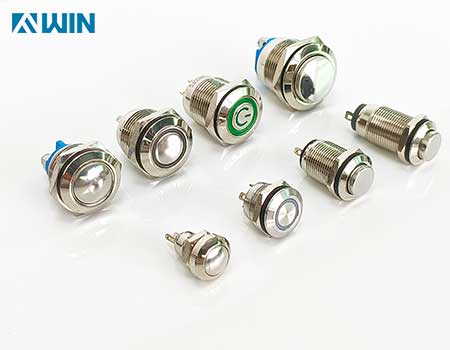Push button switches are essential components in numerous devices and systems, serving as the primary interface for user control. Selecting the right push button switch is crucial for ensuring optimal performance, durability, and safety. With a wide variety of designs, features, and specifications available, this guide will walk you through the key factors to consider when choosing the appropriate push button switch for your application.

1. Understand the Application Requirements
- Type of Operation: Determine whether the switch will be used for momentary (press-and-release action) or latching (stays in position until pressed again) functionality.
- Frequency of Use: For high-frequency applications, prioritize switches with a high cycle rating for durability.
- Environment: Consider the conditions where the switch will operate. For outdoor or harsh environments, opt for weatherproof or waterproof switches with appropriate IP ratings (e.g., IP65–IP68).
2. Electrical Specifications
- Voltage and Current Rating: Ensure the switch can handle the voltage and current of your system. Low-voltage systems (e.g., 12V or 24V) require switches designed for efficient operation at these levels.
- AC or DC Circuit: Some switches are optimized for alternating current (AC), while others are better suited for direct current (DC).
- Contact Resistance: Low contact resistance is essential for smooth and efficient electrical conduction, particularly in sensitive electronic applications.
3. Material and Construction
- Metal vs. Plastic:
- Metal Push Buttons: Provide superior durability, resistance to wear, and a sleek appearance, making them ideal for industrial and high-end consumer applications.
- Plastic Push Buttons: Lightweight and cost-effective, suitable for basic or temporary applications.
- Corrosion Resistance: For marine or outdoor use, select switches made of stainless steel or other corrosion-resistant materials.
4. Mechanical Features
- Actuation Force: Consider how much force is required to press the button. Light-touch switches are ideal for user-friendly applications, while heavier actuation may be better for environments prone to accidental activation.
- Tactile Feedback: Look for switches that provide clear feedback (clicking or snapping action) to ensure the user knows the input was successful.
- Size and Mounting Style: Ensure the switch fits the space available and is compatible with the panel or device. Options include threaded mounting, snap-fit, or PCB-mounted designs.
5. Illumination Options
- LED Illumination: Push button switches with integrated LEDs provide visibility in low-light conditions and can serve as status indicators.
- Multicolor LEDs: Useful for applications requiring multiple states or feedback, such as power, standby, or fault indicators.
- Voltage Compatibility: Verify that the LED illumination matches the power supply voltage.
6. Customization and Aesthetics
- Symbols and Legends: For ease of use, consider switches with engraved or printed symbols that represent their function, such as power, reset, or emergency stop.
- Design and Finish: Choose finishes (e.g., polished, brushed, or anodized) and colors that align with the aesthetic of your device or system.
7. Safety Considerations
- Insulation: Ensure the switch provides proper insulation to prevent electrical hazards.
- Fail-Safe Design: For critical applications like emergency stops, select switches with fail-safe mechanisms.
- Tamper Resistance: Anti-vandal push buttons are ideal for public installations where tampering or vandalism is a concern.
8. Cost and Longevity
- Budget: Select switches that offer the best balance between cost and required features. For long-term applications, investing in a durable, high-quality switch can save money on replacements and maintenance.
- Life Cycle Rating: Choose switches rated for the expected number of cycles based on your application’s usage frequency.
9. Compliance and Standards
- Industry Standards: Ensure the switch complies with relevant certifications (e.g., CE, UL, or RoHS) for safety and performance.
- Specific Regulations: For specialized fields like medical or automotive, verify that the switch meets the required standards for that industry.
10. Testing and Prototyping
- Prototyping: Test a sample switch in your system before finalizing your choice to ensure compatibility and performance.
- Supplier Support: Work with trusted suppliers who can provide detailed specifications, guidance, and technical support.
Conclusion
Selecting the appropriate push button switch involves understanding your application’s functional, environmental, and aesthetic needs. Factors such as voltage compatibility, material durability, mechanical performance, and safety features play a significant role in the decision-making process.
By carefully evaluating these considerations, you can choose a push button switch that meets your requirements, enhances the performance of your system, and delivers a reliable and satisfying user experience. Whether for industrial machinery, consumer electronics, or outdoor installations, the right push button switch ensures operational efficiency and long-term reliability.